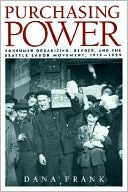

 |

|

The average rating for Purchasing Power: Consumer Organizing, Gender, and the Seattle Labor Movement, 1919-1929 based on 2 reviews is 3.5 stars.
Review # 1 was written on 2013-10-21 00:00:00 Jason Mccomb Jason MccombI really liked this book, despite the feeling that I got that Frank entered into the study with a point s/he wanted to make and then found a time and place to illustrate it. It was a point that I an argument/lesson that I am interested in and I loved getting to delve into the nitty-gritty of labor history in a specific place in a specific decade. I really appreciated that Frank looked at unwaged work by when in their homes. Also I had to read Saxton in college and I appreciated Franks treatment of anti-Asian activism in Seattle during the 20's. I was reading this book while in Seattle and it was super interesting hearing on the news about the Machinists at Boeing now and thinking about the connections to the ship building yards during WWI. AND, I loved reading about the tactic of "buy local" that the AFL engaged in during its retreat after the 1919 general strike in Seattle. All so interesting! |
Review # 2 was written on 2017-07-29 00:00:00 Dell Isam Dell IsamBarber argued that the Students for a Democratic Society (SDS) collapsed suddenly in 1969, just a year after having 100,000 members, and was absent for the height of the anti-war movement a year later, because of its failure to address its own internalized racism, sexism, and classism, as well as connect domestic oppression with international imperialism. Because it failed to heed the call by both the Black Panther Party and third world revolutionaries like Cubans and Vietnamese to organize within white communities, particularly within the white working class, and instead condemned all working class whites as hopeless stooges, it eventually fell into factionalism by what Barber terms the traditional old left PLP and the macho Weathermen. SDS had its origins as white civil rights workers whom spent freedom summers in the South organizing with SNCC, but ultimately struggled to grapple with their own role within white supremacy and empire, failing to make connections between at-home racism and international empire. Barber says this is because white student radicals failed to look to black intellectual traditions that made those connections, like Dubois and Malcolm X. Additionally, they failed to address sexism within SDS and male supremacy of the organization, and when women did stand up, they sidelined black feminists who argued for the need to connect gender to race. When the anti-war movement came to a head with the invasion of Cambodia, the Kent State shootings, the biggest radical organization was gone and replaced by ineffective small cliques, unable to challenge liberal control of the anti-war movement that now sidelined black nationalists and said Vietnam was a mistake as opposed to a part of the larger history of the US. Barber divides the book into 5 sections. The first looks to the relationship between the white SDS and black movements, noting the SDS wavered on race, addressing it at times but sidetracking it at other times, and failing to challenge its own notions as the leader of revolution and listening to black revolutionaries when they were under attack. The second section explores why SDS could not connect empire to domestic capitalism, arguing it was because of lack of engagement with black intellectual traditions that made those connections. The weathermen then did actions in support of black nationalists and Vietnamese that were largely ineffectual at the moment, Barber argues. The third section looks to the gender breakdowns, as it was dominated by white men and white women tended to do the shit work. White men expected their voices to be heard and for it to have effects, meaning white men talked a lot more and did not do the day to day work. They failed to engage with them. When they did, it was in a sort of "smash monogamy" that only guaranteed free access to sex for men. The final two chapters look to SDS's collapse, as both the Progressive Labor Party and the Weathermen sought to sideline race issues with either class or machoism. While early attempts in SDS did engage with poor white community organizing, these fell behind. Key Themes and Concept -Failure to engage with race/class/gender dynamics of SDS doomed it as it fell to factionalism. -SDS failed to help black nationalists, particularly the Black Panther Party, when it was under attack and dissolved at the height of the government assault. This was after ignoring its advice because it saw itself as the vanguard of the revolution, even if it was not traditionally Marxist-Leninist, and failed to break with middle class white male notions of leadership. Even after being asked to organize in its white communities, SDS members instead either left the New Left or condemned whites as utterly hopeless and gave up on them for symbolic actions. -Barber argues that there are two schools of thought that detail the history of the New Left: 1) the liberal school (Todd Gitlin, Maurice Iserman, Tom Hayden) that argues that it collapsed when white student followed black nationalists to rage which alienated the mainsteam. 2) the radical school (Ron Jacobs, Jeremy Varon, Max Elbaum, Dan Berger) which argues that the New Left sought to build upon the relationship with the Third World revolutionaries and black nationalists. Barber argues that SDS and the white New Left never followed what black nationalists and the Third World liberationists asked for. |
CAN'T FIND WHAT YOU'RE LOOKING FOR? CLICK HERE!!!